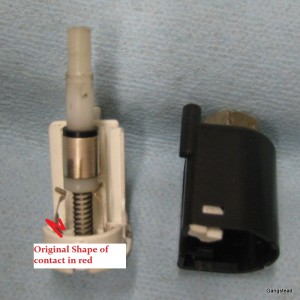One of my favorite things to do is to come home late from work on a brisk February evening and stick my arms in cold pool water. Yes it’s a mild winter, but 45 degree water is chilly nonetheless. I wasn’t doing this just for fun, the little rug rat that runs around the bottom of the pool picking up leaves was broken. My arms have finally thawed enough for me to write about this simple fix.
I noticed that the last couple weeks no matter how much the Polaris (model number 280) ran around it didn’t seem to be picking up anything and the bag was empty. I’ve known for a few months that my filter cartridges were failing and sand and other tiny debris was getting through and back into the pool. What I suspected was that some tiny thing had made its way through the auxiliary pump and down the hose and blocked up the spray nozzles that push vacuum leaves up. Usually when something is wrong with the Polaris its that it won’t move forward. With the Polaris running I pulled it up by the hose so that it was just barely out of the water. I could tell that only a little water was coming out of the jets that point up into the bag. I knew from prior observation that it should be blasting water out of that thing and soaking me, so I knew where the problem was.
Now here’s the tricky part. I could tell that there was a tiny little pebble in each of the two tips of the nozzles. I poked them down with a little screw driver and tried to shake them out, but when I covered the top hole with my thumb and blew into the hole where the directional ball nozzle goes they would go back to clogging the holes. After turning blue in the face trying to blow out the pebbles I realized I had an air compressor. That helped tremendously. Put the air in one of the tiny holes, cover the other and the top hole with your fingers and hopefully the pebble will blow out the back. Don’t stop until you have found the pebble in your hand. I thought I had it out one time and put it together and it clogged itself back up within a few seconds.
It goes right back together and since then it has warmed up enough for me to fix the root cause and replace my cartridge filters.
Time
30 minutes
Cost
Free








